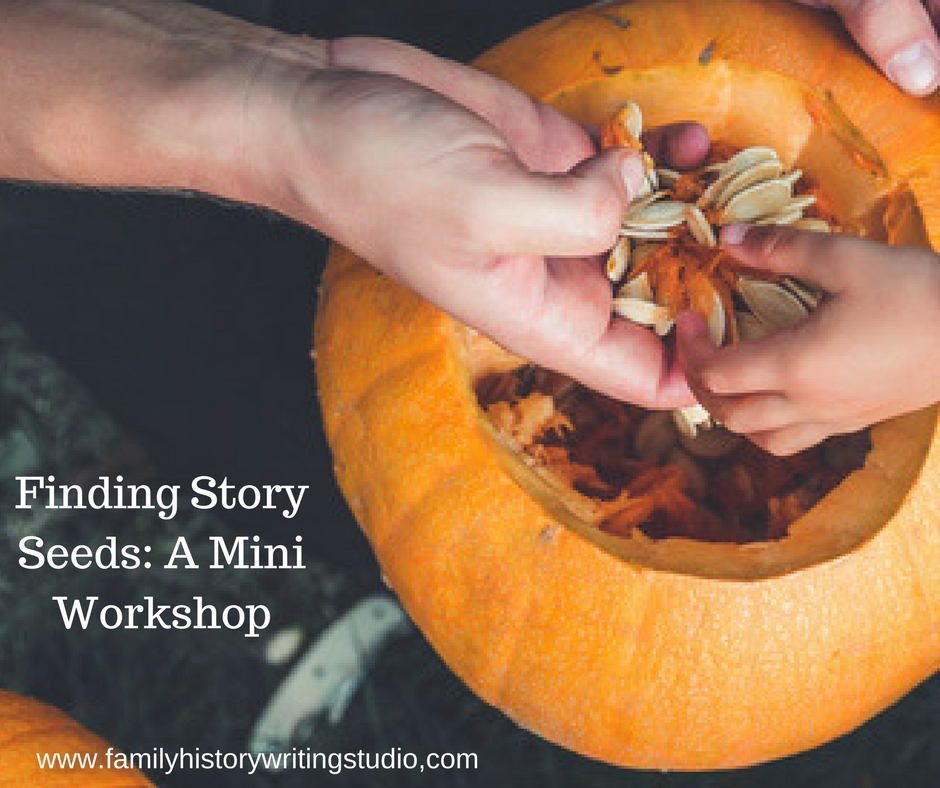[iframevideo]
[/iframevideo]
[iframevideo]
[/iframevideo]
Comments are closed.

Join the Wait List for Our Next Virtual Writer’s Retreat.
Coming this Fall
Jump Start Your Story Writing!

All too often when we think about writing our family history stories, we contemplate writing about those big story ideas. We want to write an ancestor’s life story from birth to death. We think about writing our family history from as far back as we have researched to present day. These are pumpkins. Gigantic pumpkins.
Your family history might very well be an inspiring and insightful story. But when writing your family history, you don’t always have to go big. Sometimes there are little seeds of stories buried within your research. I love those stories because they zoom in and show our ancestors in their most personal moments. These intimate moments will resonate with your readers.
Often, we have these pumpkin size ideas. Pumpkin ideas are cumbersome and hard to carry. They tend to wear us down. They are overwhelming. When you write about huge topics, you can tire out and lose interest. Huge topics can also be challenging to write, with so many aspects to consider. It’s more fun to dig out the seeds than carrying around a big awkward pumpkin.
For example, my mother’s life story is a pumpkin size idea. It’s a huge pumpkin with over 85 years of life to write about. Even if I break her life story down into subtopics, they can still be significant. Watch me do this with my mother. I jot down pumpkin-sized ideas in my notebook.
They might look something like this:
In my notebook, I have carved up my pumpkin and listed all sorts of things that were interesting about my mother’s life, as you can see above.
Now that I’ve carved up my pumpkin, I begin to see the seeds and start to pull out those seeds.
Ohhhh, see that!? Now, these moments are starting to sound more like stories, and less like topics. You saw how I did that, right? Finding my seed ideas inside that big pumpkin of a life story.
Now, you may already have ideas that are somewhat specific. Maybe you’ve carved your pumpkin already instead of leaving it whole. But I challenge you to zoom in and pull out those small seeds.
Grab your writing notebook, and identify an ancestor you want to write about. This is your pumpkin idea.
Next, create subtopics, carve up that pumpkin, usually around time periods or significant events in your ancestor’s life. They may look like this:
Next, take that carved pumpkin and pull out the seeds, those little ideas within those topics.
For example,
Immigration
Job
Marriage
Seed ideas are usually memorable moments in a person’s life, but they also can trigger random specific moments in their life that can hold significant meaning.
If you’ve been struggling to get your family history stories out, I’d suggest it could be that you’re carrying too large of an idea. Every time you write, remember to zoom into your ideas, carve up the pumpkin and start to pull out those small seeds. A seed idea is quite fun and manageable to write about!
onc again, thank you.. for an enlightening topic. My ancestor was in the revolutionary war as a loyalist….and of course he had opposition (enemy) but thank you for pointing out other things my ancestor would have faced, revenge on his family, disease, smallpox was rampant. in a seven years of war meant 7 winters on the east coast and what that would mean, and the spring thaw of snow meant mud in the refugee camps that were just primitive huts so the cold would be an enemy they couldn’t avoid or control with the flick of a thermostat
Thank you for helping me to think!
Always thoughtful ideas to improve our storytelling. I love to consider economic obstacles – In my case I am looking at poverty as one. Also, the disbanding of the family unit when my protagonist was so young. His role models are external and it creates a challenge to create the connected home he longs to achieve.
You have my attention!
Writing of the complications in life better than a timeline but as antagonist in all the ways you listed would be better story telling!
Thank you for teaching me that.